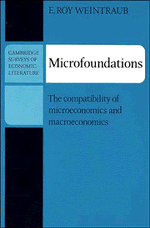Summary
In this part attention will be directed to the various ways in which general equilibrium theory has been, and is being, modified to provide a conceptual base for the formulation of macroeconomic concerns.
Two major approaches can be identified: the first focuses on interdependent optimization by the various agents, the second is more concerned with the mechanisms for exchange or transactions. Abusing both language and history a bit, the former will be termed (neo-)Walrasian analysis, the latter (neo-)Edgeworthian. A further bifurcation will be between equilibrium theory and disequilibrium theory, or whether the analysis is directed to the possibility of pre-reconciled choice or the attainment of terminal states in real time.
There are thus four “pigeonholes” in which to place recent and current work. The taxonomy consists of Walrasian equilibrium (Chapter 6), Walrasian disequilibrium (Chapter 7), Edgeworthian equilibrium (Chapter 8), and Edgeworthian disequilibrium (Chapter 9).
- Type
- Chapter
- Information
- MicrofoundationsThe Compatibility of Microeconomics and Macroeconomics, pp. 87 - 88Publisher: Cambridge University PressPrint publication year: 1979



